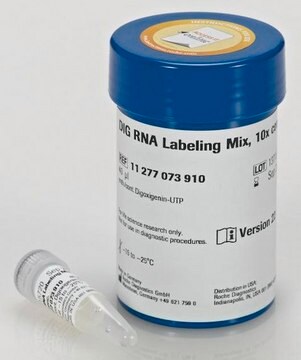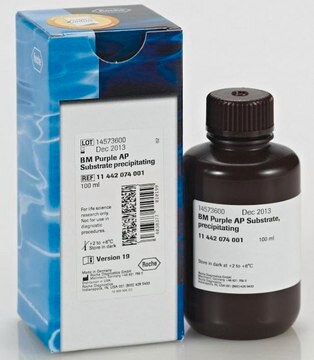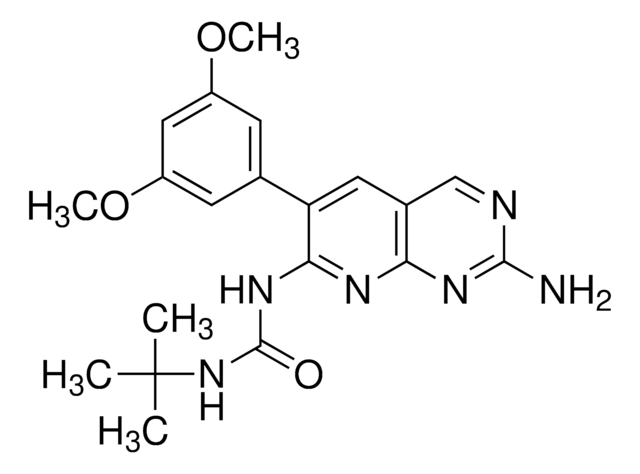RPOLSP6-RO
Roche
SP6 RNA Polymerase
from Escherichia coli BL 21/pSR3
Synonym(s):
mRNA, polymerase
About This Item
Recommended Products
biological source
Escherichia coli (BL 21/pSR3)
Quality Level
Assay
100% (SDS-PAGE)
form
solution
specific activity
≥20 U/μL
mol wt
96 kDa (Single polypeptide chain)
packaging
pkg of 1,000 U (10810274001)
pkg of 5,000 U (11487671001)
manufacturer/tradename
Roche
technique(s)
DNA sequencing: suitable
Northern blotting: suitable
Southern blotting: suitable
color
colorless
pH
~7.9 (39 °F)
solubility
water: miscible
suitability
suitable for molecular biology
UniProt accession no.
application(s)
genomic analysis
life science and biopharma
foreign activity
Endonucleases, none detected (up to 30U using Lamda-DNA)
Endonucleases, none detected (upto 30U using MWM III-DNA )
Nicking activity, none detected (up to 30U using pBR322-DNA)
RNase, none detected (up to 30U using MS II- RNA )
storage temp.
−20°C
Gene Information
Escherichia coli ... rpoB(948488)
General description
Contents:
- SP6 RNA Polymerase, ≥20 U/μl, in buffer, pH 7.9
- Transcription Buffer, 10x concentrated
Specificity
SP6 RNA polymerase is extremely promoter-specific and only transcribes bacteriophage SP6 DNA or DNA cloned downstream of a SP6 promoter (e.g., pSPTBM20; pSPTBM21).
Heat inactivation: Stop the reaction by adding 2 μl 0.2 M EDTA (pH 8.0) and/or heat to 65 °C.
Application
- RNA or DNA blotting techniques
- In situ hybridization
- RNase protection studies: Transcripts synthesized by the enzyme are used as precursor RNA for studies on RNA splicing and processing.
- Synthesis of capped RNA in vitro with addition of m7GpppG or m7GpppA in excess over GTP or ATP during the transcription reaction. The generated antisense RNA can be introduced into cells to suppress the expression of the corresponding genes.
- The synthesis of antisense RNA probes
Quality
40 mM Tris-HCl, pH 8.0 (+20°C), 6 mM MgCl2, 10 mM dithiothreitol, 2 mM spermidine, pH approximately 8.0 (+20°C).
Absence of Endonucleases
1. 1 μg lambda DNA is incubated with SP6 RNA polymerase for 4 hours at +37°C in 25 μl test buffer. The number of enzyme units which show no degradation of lambda DNA is > 30 U.
2. 1 μg Eco RI/Hind III fragments of lambda DNA is incubated with SP6 RNA polymerase for 4 hours at +37°C in 25 μl test buffer. The number of enzyme units which show no alteration of the banding pattern is > 30 U.
Absence of Nicking Activity
1 μg pBR322 DNA is incubated with SP6 RNA polymerase for 4 hours at +37°C in 25 μl test buffer. The number of enzyme units which show no relaxing of supercoiled structure is > 30.
Absence of RNases
4 μg MS2 RNA are incubated with SP6 RNA polymerase for 4 hours at +37°C in 50 μl test buffer. The number of enzyme units which show no degradation of MS2 RNA is > 30.
Performance in Transcription Assay
SP6 RNA polymerase is function tested in the SP6/T7 Transcription Kit (Cat. No. 10 999 644 001). The incorporation rate in the standard assay with 0.5 μg pST18 neo DNA linearized with Eco RI and 50 mCi [alpha-32P] CTP, [400 Ci/mmol (15 TBq/mmol)] gives >50% of the input radioactivity in 20 minutes.
Specifications
Suitable labels: Transcripts can be nonradioactively labeled with biotin-16-UTP, DIG-11-UTP, or fluorescein-12-UTP. They may also be radioactively labeled to high specific activity with [a-32P]- or [a-35S]-labeled nucleotides.
Note: Roche has 10x concentrated RNA Labeling Mixes that are specially designed for DIG-, biotin-, and fluorescein-labeling. These mixes work well with SP6 RNA Polymerase.
Unit Definition
Volume Activity: ≥20 U/μl
Preparation Note
Storage and Stability
Other Notes
Kit Components Only
- SP6 RNA Polymerase, in buffer, pH 7.9 ≥20 U/μl
- Transcription Buffer 10x concentrated
also commonly purchased with this product
Signal Word
Warning
Hazard Statements
Precautionary Statements
Hazard Classifications
Eye Irrit. 2
Storage Class Code
12 - Non Combustible Liquids
WGK
WGK 1
Flash Point(F)
does not flash
Flash Point(C)
does not flash
Certificates of Analysis (COA)
Search for Certificates of Analysis (COA) by entering the products Lot/Batch Number. Lot and Batch Numbers can be found on a product’s label following the words ‘Lot’ or ‘Batch’.
Already Own This Product?
Find documentation for the products that you have recently purchased in the Document Library.
Customers Also Viewed
Our team of scientists has experience in all areas of research including Life Science, Material Science, Chemical Synthesis, Chromatography, Analytical and many others.
Contact Technical Service








